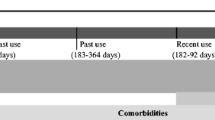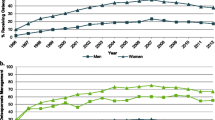Abstract
Summary
Although systemic glucocorticoids are commonly used, it is difficult to obtain accurate exposure history. In 50,000 patients, we confirmed that glucocorticoids were associated with reductions in bone mineral density (BMD) and increases in fracture and documented that recent and prolonged durations of exposure were particularly associated with adverse events—dose information did not improve risk prediction.
Introduction
Systemic glucocorticoid use, defined as ever having taken supra-physiologic doses for 90-days or more, is a risk factor for low BMD and fractures. This definition does not distinguish recent (vs remote) exposure.
Methods
Within a population-based clinical BMD registry in Manitoba, Canada, we identified all adults over age 40 years tested between 1998 and 2007 and then undertook a cohort study. We identified all oral glucocorticoid dispensations from 1995 to 2009 and stratified exposure by timing (“recent” if within 12 months vs “remote”) and duration (short [<90 days] vs prolonged [≥90 days]). Osteoporosis-related risk factors and treatments and major fractures were obtained using administrative health data.
Results
A total of 12,818 of 52,070 (25 %) subjects had used glucocorticoids prior to BMD testing; the most common exposure was remote short (n = 6453) vs recent prolonged (n = 2896) vs recent short (n = 2644) vs remote prolonged (n = 825). Compared to 39,252 never-users, only recent prolonged glucocorticoid use was significantly associated with femoral neck T-score (ANCOVA-adjusted difference −0.13, 95 % CI −0.16 to −0.10, p < 0.001). There were 2,842 major (566 hip) fractures over median 5-year follow-up. Compared with never-users, only recent prolonged glucocorticoid use was significantly associated with BMD-independent increases in risk of incident major fracture (5.4 vs 7.7 %, adjusted HR 1.25, 95 % CI 1.07–1.45, p = 0.004) and hip fracture (1.1 vs 1.8 %, adjusted HR 1.61, 95 % CI 1.18–2.20, p = 0.003).
Conclusions
Recent and prolonged glucocorticoid use (but neither remote nor recent short courses) was independently associated with reduced BMD and increased risk of fractures. These findings should permit clinicians to identify a high-risk group of patients that might benefit from osteoporosis prevention.


Similar content being viewed by others
References
Majumdar SR, Lix LM, Yogendran M, Morin SN, Metge CJ, Leslie WD (2012) Population-based trends in osteoporosis management after new initiations of long-term systemic glucocorticoids (1998–2008). J Clin Endocrinol Metab 97:1236–1242
Weinstein RS (2011) Glucocorticoid induced bone disease. N Engl J Med 365:62–70
Lekamwasam S, Adachi JD, Agnusdei D, Bilezikian J, Boonen S et al (2012) A framework for the development of guidelines for the management of glucocorticoid induced osteoporosis. Osteoporos Int 23:2257–2276
Van Staa TP, Luefkens HG, Cooper C (2002) The epidemiology of corticosteroid induced osteoporosis: a meta-analysis. Osteoporos Int 13:777–787
Kanis JA, Johansson H, Oden A, Johnell O, de Laet C et al (2004) A meta-analysis of prior corticosteroid use fracture risk. J Bone Miner Res 19:893–899
Van Staa TP, Leufkens HG, Abenhaim L, Zhang B, Cooper C (2000) Oral corticosteroids and fracture risk: relationship to daily and cumulative dose. Rheumatology 39:1383–1389
Van Staa TP, Leufkens HG, Abenhaim L, Zhang B, Cooper C (2000) Use of oral corticosteroids and risk of fractures. J Bone Miner Res 15:993–1000
De Vries F, Bracke M, Leufkens HG, Lammers JW, Cooper C, van Staa TP (2007) Fracture risk with intermittent high-dose oral glucocorticoid therapy. Arthritis Rheum 56:208–214
Kanis JA, Johansson H, Oden A, McCloskey EV (2011) Guidance for the adjustment of FRAX according to the dose of glucocorticoids. Osteoporos Int 22:809–816
Kanis JA, Oden A, Johansson H, Borgstrom F, Strom O, McCloskey E (2009) FRAX and its application to clinical practice. Bone 44:734–743
Leslie WD, Lix LM, Tsang JF (2007) Single-site vs multi-site bone density measurement for fracture prediction. Arch Intern Med 167:1641–1647
Leslie WD, Caetano PA, MacWilliam LR, Finlayson GS (2005) Construction and validation of a population-based bone densitometry database. J Clin Densitom 8:25–30
Targownik LE, Lix LM, Leung S, Leslie WD (2010) Proton pump inhibitor use is not associated with osteoporosis or accelerated bone mineral density loss. Gastroenterol 138:896–904
Majumdar SR, Ezekowitz JA, Lix LM, Leslie WD (2012) Heart failure is a clinically and densitometrically independent risk factor for osteoporotic fractures: population-based cohort study of 45,509 subjects. J Clin Endocrinol Metab 97:1179–1186
Acknowledgments
The authors are indebted to Manitoba Health for the provision of data (HIPC File No. 2007/2008-49). The results and conclusions are those of the authors, and no official endorsement by Manitoba Health is intended or should be inferred. This article has been reviewed and approved by the members of the Manitoba Bone Density Program Committee. WD Leslie had full access to all the data in the study and takes responsibility for the integrity of the data and the accuracy of the analysis.
Conflicts of Interest
The authors declare no potential conflicts of interest with respect to this work. No external funding source was required for this research. SRM receives salary support from the Alberta Heritage Foundation for Medical Research—AIHS (Health Scholar) and holds the Endowed Chair in Patient Health Management (Faculties of Medicine and Dentistry and Pharmacy and Pharmaceutical Sciences, University of Alberta). SNM is chercheur-clinicien boursier des Fonds de la Recherche en Sante du Quebec. LML is supported by a Manitoba Research Chair.
Author information
Authors and Affiliations
Corresponding author
Rights and permissions
About this article
Cite this article
Majumdar, S.R., Morin, S.N., Lix, L.M. et al. Influence of recency and duration of glucocorticoid use on bone mineral density and risk of fractures: population-based cohort study. Osteoporos Int 24, 2493–2498 (2013). https://doi.org/10.1007/s00198-013-2352-3
Received:
Accepted:
Published:
Issue Date:
DOI: https://doi.org/10.1007/s00198-013-2352-3




